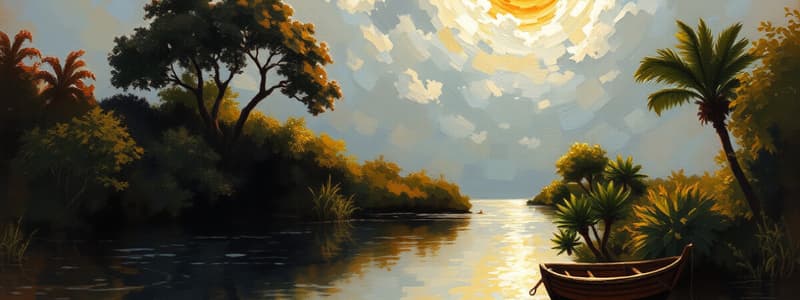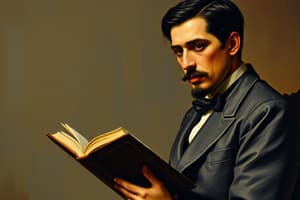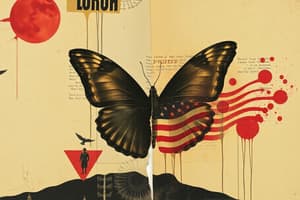Podcast
Questions and Answers
What does S.P. Lopez consider the highest form of art?
What does S.P. Lopez consider the highest form of art?
- Art that prioritizes beauty over utility
- Art focused on strict adherence to traditional forms
- Art that arises from deep compassion and longing for freedom (correct)
- Art that ignites anger towards oppressors
José García Villa's stance on art is best described as which of the following?
José García Villa's stance on art is best described as which of the following?
- Art is meant for social change
- Art is centered on personal experience and narrative
- Art should primarily be a discipline
- Art must prioritize beauty over utility and meaning (correct)
Prior to the 1920s, poetry was primarily characterized as:
Prior to the 1920s, poetry was primarily characterized as:
- Focused on personal narrative and subjective experiences
- Deeply emotional and imaginative
- Merely versification and exercises in rhetoric (correct)
- Highly experimental and modernist
What influence shaped the early 20th-century Filipino poetry?
What influence shaped the early 20th-century Filipino poetry?
How did early 20th-century poetry reflect the sentiments of its time?
How did early 20th-century poetry reflect the sentiments of its time?
What did López believe about the artist's role in society?
What did López believe about the artist's role in society?
What aspect did early poems prioritize according to the content provided?
What aspect did early poems prioritize according to the content provided?
What can be inferred about the emotional quality of early Filipino poetry?
What can be inferred about the emotional quality of early Filipino poetry?
What triggered the development of Philippine Literature in English?
What triggered the development of Philippine Literature in English?
How did the view of nationalism in Philippine literature change before the war?
How did the view of nationalism in Philippine literature change before the war?
Which publication became the most prestigious college literary publication in the Philippines?
Which publication became the most prestigious college literary publication in the Philippines?
Before the establishment of the Commonwealth, what characterized many literary attempts?
Before the establishment of the Commonwealth, what characterized many literary attempts?
What did the use of 'local color' in literature refer to?
What did the use of 'local color' in literature refer to?
Which of the following publications was NOT mentioned in the content as encouraging literary attempts?
Which of the following publications was NOT mentioned in the content as encouraging literary attempts?
Which literary movement intensified in the years leading up to World War II?
Which literary movement intensified in the years leading up to World War II?
What was a key characteristic of the elite's language preference in the previous era?
What was a key characteristic of the elite's language preference in the previous era?
What was the title of the volume published by Paz Marquez Benítez in 1928?
What was the title of the volume published by Paz Marquez Benítez in 1928?
What year did José García Villa publish the Filipino Short Stories?
What year did José García Villa publish the Filipino Short Stories?
According to José García Villa, what two elements are essential in creating a good short story?
According to José García Villa, what two elements are essential in creating a good short story?
Who was mentioned as a significant figure in promoting socially conscious writings?
Who was mentioned as a significant figure in promoting socially conscious writings?
What term did S.P. Lopez use to describe the process of making writings socially engaged?
What term did S.P. Lopez use to describe the process of making writings socially engaged?
What impact did the debate between López and Villa have on Philippine literature during the late 30s?
What impact did the debate between López and Villa have on Philippine literature during the late 30s?
What was one characteristic that Villa believed a good short story must possess?
What was one characteristic that Villa believed a good short story must possess?
What writing market did S.P. Lopez eventually refer to in regards to Filipino writers?
What writing market did S.P. Lopez eventually refer to in regards to Filipino writers?
What key event occurred around 1949 in relation to Philippine literature?
What key event occurred around 1949 in relation to Philippine literature?
Which contest is recognized as the country's most prestigious annual literary competition?
Which contest is recognized as the country's most prestigious annual literary competition?
What was a significant motivation for writers during the post-war period?
What was a significant motivation for writers during the post-war period?
Which of the following was NOT mentioned as a college paper reactivated during the post-war period?
Which of the following was NOT mentioned as a college paper reactivated during the post-war period?
Jose Garcia Villa's influence extended to which group during the post-war era?
Jose Garcia Villa's influence extended to which group during the post-war era?
Which institution offered a course in Contemporary Philippine Literature in English?
Which institution offered a course in Contemporary Philippine Literature in English?
What was the general sentiment towards post-war writers in the Philippine literary scene?
What was the general sentiment towards post-war writers in the Philippine literary scene?
Which aspect of Philippine literature was included in the civil service examination by the Bureau of Civil Service?
Which aspect of Philippine literature was included in the civil service examination by the Bureau of Civil Service?
What key event in the 1970s influenced the emergence of the Protest Motif in fiction?
What key event in the 1970s influenced the emergence of the Protest Motif in fiction?
What is one characteristic of post-modernistic traits seen in contemporary fiction?
What is one characteristic of post-modernistic traits seen in contemporary fiction?
Which of the following best describes the state of literature after the deposition of Marcos?
Which of the following best describes the state of literature after the deposition of Marcos?
What did Emmanuel Torres argue concerning poets writing in English?
What did Emmanuel Torres argue concerning poets writing in English?
What was a significant consequence of the younger writers' backtracking to socio-political realities?
What was a significant consequence of the younger writers' backtracking to socio-political realities?
What was one of the major themes in the literature influenced by student activism?
What was one of the major themes in the literature influenced by student activism?
How did the concept of 'naturalizing' English relate to Philippine literature?
How did the concept of 'naturalizing' English relate to Philippine literature?
Which aspect of reality became more conscious for fictionists during the era discussed?
Which aspect of reality became more conscious for fictionists during the era discussed?
Flashcards are hidden until you start studying
Study Notes
Language Transition
- Adaptation to English occurred as Spanish dominance waned in the elite circle during the 1930s.
- English replaced Spanish gradually, fostering a new literary landscape and discourse.
Rise of Philippine Literature in English
- Established in 1908, the University of the Philippines spurred development in Philippine literature using English.
- Publications like the UP College Folio and others (e.g., The Philippine Review, Philippine Free Press) encouraged English literary expression.
Emergence of National Literature
- The Commonwealth's establishment in 1935 prompted a shift toward creating a "national literature," focusing on local themes and cultural identity.
- Earlier writings were often personal and romantic, but the 1930s witnessed a shift to realism and social consciousness.
Literary Conflict
- A significant debate emerged between proponents of nationalism and those favoring pure artistry:
- Salvador P. López advocated art reflecting social issues and humanity's struggles.
- José García Villa promoted "art for art's sake," emphasizing aesthetic enjoyment over societal function.
Poetry and Fiction Development (1920-1941)
- Early poems resembled rhetorical exercises lacking artistic depth, primarily influenced by Romantic and Victorian styles.
- Notable collections included Filipino Love Stories and Filipino Short Stories, emphasizing vital, well-crafted storytelling.
Proletarian Literature
- S.P. López encouraged a socially conscious approach among writers, contributing to the emergence of Proletarian literature during the late 1930s.
- Literature gained a conscience, promoting awareness of social issues and injustices.
Post-War Resurgence
- Post-war literature surged with renewed publications and literary contests (e.g., Carlos Palanca Sr. Memorial Awards) supporting writer development.
- Philippine Literature in English became a core academic subject, ensuring an audience for writers.
Contemporary Literature (1971-Present)
- In the 1970s, student activism inspired a protest motif in fiction, leading to engaged literature reflecting political and social realities.
- Writers addressed poverty, social inequities, and the struggle for freedom while experimenting with post-modernism, often rejecting traditional storytelling elements.
Perspective on Language and Expression
- Emmanuel Torres highlighted challenges faced by English writers, noting exclusion from vernacular themes integral to Filipino identity.
- Emphasized the necessity of naturalizing English to reflect Filipino culture, ultimately advocating for a national language in literature.
Studying That Suits You
Use AI to generate personalized quizzes and flashcards to suit your learning preferences.




